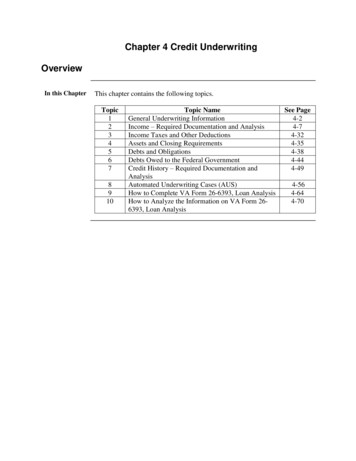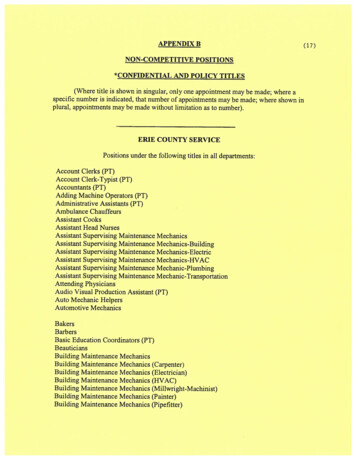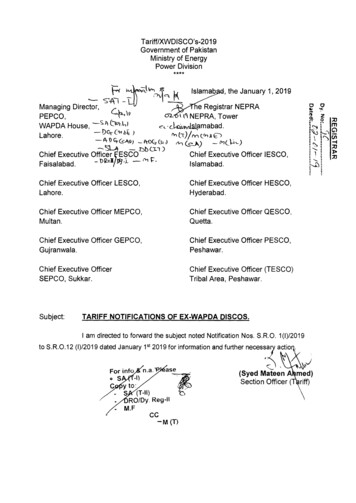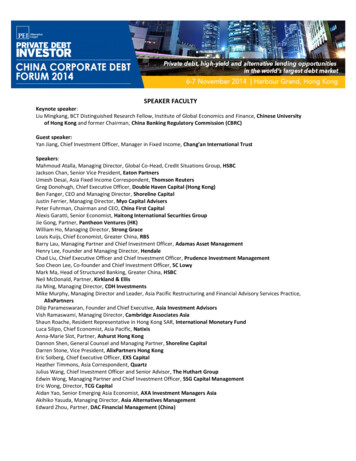
Transcription
The futureof the ChiefUnderwritingOfficer
Today, in most insuranceorganizations the underwritingfunction is fragmented into marketsegment or lines of business. Theseprofit and loss centers drive demandfor product, and technology solutionsfor their areas. Although this modelcan encourage internal competitionand tactical success, it has alsoresulted in fragmented underwritingprocesses, operations, data andsystems. As a consequence, insurersare left with IT environments andoperations that are costly to maintainand difficult to change. They alsolack the resources needed to drivestrategic investments.The world of underwriting is poised for dramatic change. Both Property & Casualty and LifeInsurers face similar issues with this fragmented approach to underwriting: Personal Lines: use different data vendors for similar information across linesof business. Life Insurance: apply multiline and multichannel strategies while still implementingbasic forms of automation. Commercial Insurance: use different underwriting processes, tools, and systemsacross each line of business, even for similar functions. Group Benefits: struggle to ingest submission requests across multiple lines ofbusiness and to easily issue integrated quotes.Insurers don’t have to accept this current approach as inevitable or inflexible. Technology,data, and advanced analytics provide the potential to lead insurance underwriting acrossboth P&C and Life insurance sectors to create solutions that are faster, more accurate, andnimbler to customer and market needs.What’s holding the industry back? The structure of most underwriting organizations isprohibiting strategic change. For underwriting to reach its new human and technologicalpotential requires strategic underwriting leadership. The Chief Underwriting Officer is bestpositioned to lead strategic change.2The future of the Chief Underwriting Officer
Today’schallengesThe underwriting environment is becoming more complex.Producers, agents, brokers, and customers expect faster andmore cost-effective quotes. At the same time, risk evaluationis becoming more complex with new risks, exposures, anddata sources. Seen one way, these are risks. Seen another,they are opportunities.The P&C space has been a trailblazer here on many fronts.A customer can quickly access a pay-as-you-drive autoinsurance policy that monitors their driving in real-time, forexample. Other parts of the industry are catching up. Manylife carriers, for example, are exploring the use of alternativedata sources to assess risk and provide faster decisions onless complex policies.Insurers need to make strategic underwriting investmentsthat will not only improve operating efficiency andunderwriting accuracy but also enable them to innovateand quickly adapt to changing market conditions with newproducts. While lines of business can have strong tacticalviews, carriers lack the resources to solve these challengesfor each line of business separately. They need the speed,scale, and benefits that only come from a holistic enterpriseapproach to attacking these challenges.3The future of the Chief Underwriting Officer
TheleadershipgapA lack of centralized, strategic underwriting leadershipcontributes to its lag in innovation and cost performancecompared to other areas of the organization, such as claims andoperations. In some organizations we have seen the COO or theCIO attempt to drive strategic change in underwriting, but theseefforts tend to be limited to operational sourcing or technologyalignment plays. They lack the vision to drive a true strategicdirection for underwriting.The emerging role of the CUOThe CUO role in insurance companies has traditionally focusedon maintaining underwriting standards, driving underwritingquality, and balancing capital utilization across the different linesof business. Performing a critical coordination and compliancefunction, the CUO has not usually been responsible for settingunderwriting strategy or driving improvements in efficiency.Instead, P&L owners conduct these activities for their respectivelines of business.This creates a challenge in today’s business environment. Truly transformingunderwriting with the intelligent tools available today requires a level of commitmentand investment that is difficult for a single division to achieve on its own. The toolsto improve underwriting tasks have been available for years, but to really achieve theROI goals, investments need to occur across the divisions, which has been difficultto coordinate and sustain.If insurers are to become future-ready organizations, the role of the CUO needs tobe elevated to a strategic level within the organization. This change will mirror similartransformations seen with CIOs, CFOs and COOs as these roles have evolved fromoperators to strategic drivers. Underwriting is due for a similar transformation today.4The future of the Chief Underwriting Officer
EnterprisestrategicagendaAs we see it, in today’s environment there are 5 key strategicchallenges in underwriting that require an EnterpriseUnderwriting approach.5The future of the Chief Underwriting Officer
1. Underwriting operationsOne of the biggest challenges that underwriting faces is how to significantlyreduce costs while maintaining or improving underwriting quality. While lineof business solutions can yield some benefit, real cost take-out can onlybe achieved by rethinking the underwriting process and driving innovativesolutions that balance process reengineering, sourcing, intelligent solutions,and enablement to improve performance. This is particularly important (andchallenging) given changes seen in major risk demographics, which have beenaccelerated by the COVID-19 pandemic. An enterprise approach to tools likeAI and automation have the potential to deliver a 30-40% cost reduction, but itrequires significant focus, discipline, and decision making to achieve.6As an example, Accenture is helping one carrier review its quoting process forgroup benefits across multiple lines. The carrier currently uses different workflowtools, rating tools, quote generation, and approaches to personnel. No single lineof business has the resources, time, or can generate the return on investmentto really transform the underwriting process to be faster, cheaper, and morecost-efficient on its own. However, by taking an enterprise approach across thedifferent product lines and market segments, we can create a strategic plan forunderwriting that will benefit all the areas with significant savings.ReengineerIntelligentenablementData cesRedesign your UW processto make the best use ofUW resources and positionyourself for technology andother options.Evaluate where youcan use the full suite ofintelligent enablementtools. Don't just pick onetool and think everythingis a nail.Rethink group dataand how internal andexternal data insights andvisualizations, especiallycomparitive analytics, canhelp the UW to decide.Being able to identifyand intercede withcustomers who areknown to be shoppingimproves win rates.Focus on improvingthe experience andinteraction with yourdistribution partnersand customers.Especially during theproposal and closeprocess.The future of the Chief Underwriting Officer
2. Underwriting platformsToday, we see an evolution in the needs of underwriting. Carriers are generally unsatisfied with their current underwriting systems, workflows, and analytics skills.Underwriting-related systems average satisfaction levelsUS Property/Casualty insurers (n-77)Underwriting-related systems enhancement/replacement plansUS Property/Casualty insurers hVery StrongCore PASStrongWorkflow/BPMAcceptableSource: Novarica – Research Digest: Underwriting (2021)7The future of the Chief Underwriting OfficerPoorBI/AnalyticsVery PoorU/WWorkbenchReplacementCore PASWorkflow/BPMMajor EnhancementBI/Analytics
Underwriting needs three major capabilities:1. Rating and quoting solutions that enable it to set up, rate, andprice the needed packages for customers.2. Workflow solutions that can manage submissions, teams,documents, and data through either traditional or straight throughunderwriting processes.3. Emerging data platforms that can cleanse, supplement, assess,model, present, and automate elements of the underwritingprocess to drive ongoing improvements.At a minimum, the underlying platform technologymust be cloud-based and flexible with open APIs thateasily connect to new data sources as well as providecompute power for AI-based underwriting that willrequire ever greater amounts of data to build effectivepredictive models.The good news is that, once implemented, these platforms have thepotential to create a self-reinforcing “virtuous circle” of data.We see AI emerging in life insurance as carriers seek to improve the buyingexperience—particularly for younger generations and first-time buyers—by eliminating paramedical exams. Instead, predictive models use healthand wellness data, in addition to imputed data from clinical sources, as asubstitute for fluids.For example, one carrier’s lines of business developed 92 analytical modelsto help their underwriters address different segments and products. Eachmodel was unique and while they may have provided insights, poor designlead to minimal use and return. Instead, a strategic enterprise underwritingapproach to data, analytics, and model enables a single set of investmentsand tools to significantly improve underwriting.8The future of the Chief Underwriting Officer
Designing for the ment3rdGenerationIntelligentProcessingDigital UnderwritingCreate a UW Data StoreDigitize Existing UW Data andSupplementUnderwriting Data2ndGenerationUW DesktopsProcessing Data1stGenerationPolicy PlatformsPolicy/Rating DataBuild Intelligent view of information tosupport processingIntegrate and eliminate outlying toolsAnother carrier in the life insurance space leveraged its underwriting platformacross several distribution channels, using a multivariate rules engine andautomating the evidence gathering process.This combination enabled straight-through processing, including fast,accurate underwriting decisions, which boosted new business and operatingefficiency, freeing underwriting capacity to focus on applications requiringgreater discernment.9The future of the Chief Underwriting OfficerOther notable examples here include: Zurich’s implementation of ZCAM, an AI customer analytics platformfor distribution networks and underwriters in Switzerland and Italy. Mapfre Spain’s piloting of intelligent automation and NLP solutionto achieve higher operational efficiency in its global risk operations. Zurich One-Path’s harnessing of AI-driven underwriting to eliminatelengthy manual processes in life insurance.
3. InnovationThe market landscape is one of the biggest changesin underwriting. There are significant changes in bothproduct and distribution as the market fragments into newchannels and new product types. Innovation, in part, isbeing driven by the competitive threat of insurtechs.Online brokers and point of sale intermediaries are creating newdistribution channels. The boundaries are being pushed even further asOEMs (Original Equipment Manufacturers such as cars and trucks) andOSPs (Original Service Providers such as payroll firms, benefit firms, andother service providers) become sales channels or even competitors.To be effective at launching and growing new channels or new products, insurersneed to use a strategic approach to balance innovation with enterprise resourcesto best test, learn, grow, or abandon ideas at innovation speed. An enterpriseunderwriting approach to innovation is a key part of making this a success.OEM/OSP market playsMarketerNew sources of data from IoT (Internet of Things – vehicle information,wearables, sensors, etc.) as well as from service providers with uniqueinformation on health and wellness, sales, finances, employees, or usageare also creating the opportunity for new, bespoke products deliveredthrough a personalized digital experience. In fact, Accenture researchshows 58 percent of consumers aged 55 say they would sharesignificant data for personalized services to help them prevent injury andloss—an increase of 24 percent from just two years ago.2In aggregate these changes are pushing insurance out of the “PolicyAdministration Age” that began in the 2000s and into a new era definedby use of third-party data, predictive modelling, and augmentation ofexisting data.10 The future of the Chief Underwriting OfficerAgent / Broker / MarketplaceMGA / MGUMGA TPACarrier
4. Responding to theevolving customerAcross the different lines of business and products, customers are changing. TheCOVID-19 pandemic accelerated digital buying and it is here to stay. But prior toCOVID-19, consumers expected a completely digital insurance buying experienceon par with that of most online shopping sites.From a business customer perspective, distribution partners are consolidating andexerting more influence on carriers’ operations and underwriting. With this shift,carriers are focusing on designing strategies that make it easier to do businesswith major partners. Some examples of these changes could include centralizingintake (pushing towards a single door of entry), improving turnaround times, anddriving towards consistent policy servicing. The CUO should be leading theseinitiatives and designing operating models to ensure that across P&L linespartner experiences are consistent, while not eroding operational efficienciesand the bottom line.From a consumer perspective, digital channels are becoming more common asbuying habits change. Consumers want seamless integration across channelsas well as trust in return for the data they share. A recent global survey fromAccenture found that 49 percent of consumers are willing to share more personalinformation with their insurer in return for added benefits or a more personalizedservice . Purchasing insurance direct is starting to move up stream from personallines and small commercial to more complex products. It’s also moving to newstreams where consumers are already present, such as wellness apps. Withthe increased adoption by customers, CUOs need to be involved in allocatinginvestment dollars to help push products to direct channels of distribution. TheCUO will play a pivotal role in aligning products from different P&L lines to thedistribution channels, which will help improve returns on investment, as well as,deliver a more consistent customer experience.11The future of the Chief Underwriting Officer5. DataData represents both a significant opportunityand challenge. Historically, underwritingresembled an iceberg—a small amountof information on the surface requiringunderwriters to ascertain the size, complexity,and risk that reside below the surface.Today, the problem is reversed. On the surface, there aremassive amounts of new information and data sourcesavailable, like the fish looking at a vast sailing ship. It sees asmall portion of the hull with no perspective on the extent ofthe entire ship.With an overwhelming supply of sources and types of data,P&L owners tend to stick with what they know: A small business carrier knows that 30% of its industrycodes are wrong, but is reluctant to rock the boat byimplementing a change. A marine carrier has the potential to know exactly wherethe cargo will be placed on the ship, but is worried thatlevel of information will change their pricing approach. A property carrier doesn’t want to use new industry floodmaps, preferring to wait and maybe build their own. A life carrier continues to rely on traditional medical andmotor vehicle data as well as and fluids to assess riskdespite a flood of new data from wearables and wellnessapps.
Selecting, evaluating, and integrating new data sourcesinto underwriting is difficult. Although interest in and use ofbig data is expanding, still only around 30% of insurers arecurrently fully leveraging it for underwriting, and actuaries arestill wrestling with building effective models in many cases.3But carriers who have done it are outperforming peers. To besuccessful, carriers need an enterprise underwriting approachand technology strategy to drive constant data evolution.For example, risk engines today and into the future will integrate with abroad range of data sources beyond conventional Medical InformationBureau, Motor Vehicle and Electronic Health Records. Each requestfor data comes with a fee that’s repeated every time an application isprocessed, even for an update to the same application. These all presentopportunities to reduce cost and redundancy. Many North Americancarriers are already using platforms like the Accenture Life Insurance &Annuity Platform (ALIP) to eliminate redundant data pulls and speed uppolicy turnaround times.However, technology on its own is not the whole answer. Consider howconsumer behavior has changed since the digital revolution. Technologyneeds to become more personal and human-centric, especially in areasof the industry that are digital laggards, like life insurance. (There is anirony here. What could be more personal than life insurance?) Technologyfundamentally can help carriers address human behavior in a morepersonalized way.Additionally, the regulatory landscape will impact data and how it’s used.From data privacy to antidiscrimination, regulations are evolving as newdata sources emerge.The CUO is once again uniquely positioned to set and drive this agenda.12The future of the Chief Underwriting Officer
The wayforwardThe need for a strategic enterprise approach to underwritingis clear. Insurers can achieve underwriting performance,expense and profitability goals, by shedding the currentdistributed approach and its costly inefficiencies. Accenturehas identified three steps that CUOs can take to transformunderwriting at a strategic level.13The future of the Chief Underwriting Officer
AI vision for underwritingWith imagination and focus, underwritting can realize the value of human machine in cementAgents / Brokers / ProducersIntelligentProcessing3rdGenerationDigital UnderwritingMGA and MGUsUsing AI, data, analytics,design and imagination;new experiences arecreated across thevalue chain improvingsales and collaborationexperiences.OEMs / OSPsSelf-Insured CorporationsThe vision starts with considering thefull possibility for insurance productsand distribution. Emerging markets withnew data disrupt traditional boundariesintegrating insurance into broadercustomer solutions.14The future of the Chief Underwriting OfficerCloud based toolsand automation,ingest, cleanse,supplement, andprepare informationfor the UW process.1stGenerationBuying Groups2ndGenerationUnderwriting DataUW DesktopsProcessing DataConsistent use ofdata, analytics, andinsights drive enhancedefficiency and improvedUW outcomes.Policy PlatformsPolicy/Rating DataThird generation underwriting solutionscombine modern platforms with big datato provide analytics, insights, data, andautomation at the points of need in theunderwriting cycle leveraging the bestattributes of Human Machine.Ecosystems andpartnerships createnew selling andservicing interactionsleading to increasedsales and retention.
1. Alignment3. VisionAlign your vision with the C-suite and gain their support to driveenterprise change in underwriting. P&L ownership in the segments hasa long focus. Make the business case for a more strategic approach tounderwriting, and as the first step to building it, you want to lead anenterprise evaluation of underwriting capabilities and opportunities.Finally, set a strategic enterprise vision for underwriting. The vision canencompass an array of issues or focus on a single strategic area. The goalis to match a plan and business case that will achieve the vision using smallincremental steps aimed at building the concept and gaining support.2. DiagnosticConduct an enterprise diagnostic. This can involve a single issue suchas expense or profitability, or a holistic review of all five strategic areasoutlined above.The diagnostic will provide an enterprise view across underwriting toidentify strengths and opportunities that support a strategic vision foraddressing the challenges and setting the new direction.15The future of the Chief Underwriting OfficerThis playbook describes similar strategies and approaches used by CFOs,CIOs, and COOs to become more strategic. Now is the time for the ChiefUnderwriting Officer to do the same and drive transformational enterprisechange required to capture today’s underwriting opportunities.If your company is ready to drive an Enterprise UW Strategy, Accenture isready to help with diagnostics, platforms, and ideas for you to consider asyou help set the future direction of underwriting for your company.
ReferencesAbout Accenture1.Novarica – Research Digest: Underwriting (2021)2.Accenture’s Global Insurance Consumer Study 20213.Novarica – Data governance: current state, objectives, and challenges (2019 10)Contact the authorsKym GullyProduct Strategy andDevelopment Lead– Accenture Life andAnnuity SoftwareMichael ReillyDirector – Insurance,UnderwritingCommunity of PracticeContributorsAndre SchliekerGlobal Insurance Research LeadAccenture Researchandre.schlieker@accenture.comAccenture is a global professional services company with leadingcapabilities in digital, cloud and security. Combining unmatched experienceand specialized skills across more than 40 industries, we offer Strategyand Consulting, Interactive, Technology and Operations services—allpowered by the world’s largest network of Advanced Technology andIntelligent Operations centers. Our 514,000 people deliver on the promiseof technology and human ingenuity every day, serving clients in more than120 countries. We embrace the power of change to create value and sharedsuccess or our clients, people, shareholders, partners and communities.Visit us at www.accenture.com.Join the conversationJuan DemarchiResearch ManagerAccenture Researchjuan.f.demarchi@accenture.comAccenture Banking BlogAccenture@bankinginsightsAbout Accenture ResearchAccenture Research shapes trends and creates data-driven insights aboutthe most pressing issues global organizations face. Combining the powerof innovative research techniques with a deep understanding of our clients’industries, our team of 300 researchers and analysts spans 20 countries andpublishes hundreds of report articles and points of view every year. Our thoughtprovoking research—supported by proprietary data and partnerships withleading organizations such as MIT and HBS—guides our innovations and allowsus to transform theories and fresh ideas into real-world solutions for our clients.For more information, visit www.accenture.com/researchDisclaimer: This content is provided for general information purposes and is not intendedto be used in place of consultation with our professional advisors. This document refers tomarks owned by third parties. All such third-party marks are the property of their respectiveowners. No sponsorship, endorsement or approval of this content by the owners of suchmarks is intended, expressed or implied.Copyright 2021 Accenture. All rights reserved. Accenture, its logo, and HighPerformance Delivered are trademarks of Accenture. This document is produced byconsultants at Accenture as general guidance. It is not intended to provide specific adviceon your circumstances. If you require advice or further details on any matters referred to,please contact your Accenture representative.
Underwriting needs three major capabilities: 1. Rating and quoting solutions that enable it to set up, rate, and price the needed packages for customers. 2. Workflow solutions that can manage submissions, teams, documents, and data through either traditional or straight through underwriting processes. 3.










